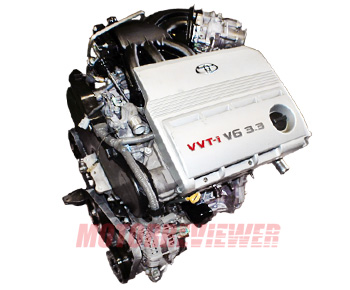Toyota 3MZ-FE 3.3L Engine Specs, Problems & Reliability

In 2002, Toyota introduced a new member of the MZ series - the 3MZ-FE. It was a 3.3-liter V6 gasoline engine, which became an alternative to Toyota's late 3.0L 1MZ with VVT-i. Both engines have the same architecture and design features. The 3MZ differs mainly by its 3.3-liter capacity and 10.8:1 compression ratio. The engine was offered for the Toyota Highlander (and Hybrid version), Toyota Camry, Solara, Lexus RX 330/400h, ES 330, and others.
Like the 1MZ, the Toyota 3.3L V6 engine has an aluminum cylinder block with a 60-degree angle between cylinder banks. It has the press-fitted cast-iron cylinder liners as well. The 3MZ-FE was equipped with a forged steel crankshaft with four main journals, forged connecting rods, and aluminum alloy pistons with a resin coating on the piston skirts for friction reduction. The engine kept the 83.0 mm stroke, but it has increased bore size in order to achieve its 3.3-liter displacement.
The 3MZ engine has aluminum cylinder heads with four valves per cylinders and belt-driven double overhead camshafts. The engine uses a timing belt to drive the exhaust camshafts only and those, in turn, rotate the intake camshafts through gears. Toyota's 3.3L MZ engines were always produced with the Variable Valve Timing - intelligence (VVT-i) on the intake side. Hydraulic lifters for the intake and exhaust valves are not provided. Valve clearance needs checking and adjustment every 60-80k miles (100,000-150,000 km).
The 3MZ-FE got sequential multi-point fuel injection system, which uses 12-hole fuel injectors. The intake manifold is made from plastic, compared to aluminum alloy for the 1MZ. The intake contains Toyota's Acoustic Control Induction System (ACIS) - it varies in two stages the effective length of the intake manifold according to engine speed. In addition to ACIS, the air cleaner intake is divided into two areas controlled by a two-stage air intake control system. This V6 engine also got the second-generation linkless electronic throttle (ETCS-i) and Direct Ignition System (DIS), where each coil fitted over a spark plug. The exhaust system includes stainless steel exhaust manifolds and no EGR.
The production of the 3MZ-FE was discontinued in 2015. At this point, it was already replaced by a new 3.5-liter V6 engine out from the GR series - 2GR-FE.
Engine Specs
Toyota Motor Manufacturing Kentucky
0.2 l (0.21 qt) - oil filter
3MZ Engine Problems and Reliability
The engine is no longer new and almost all have a lot of wear. A typical high-mileage 3MZ-FE engine often has increased oil consumption, and new ones are no longer produced. A damaged cylinder block is not rebuildable and needs a full replacement while finding a used 3MZ engine in the acceptable condition is not so simple.
With a broken timing belt, the 3MZ engine bends valves causing severe damages to cylinder heads and pistons. Also, it is afraid of overheating and is very prone to the formation of sludge on inside walls, as well as carbon deposits inside intake ports. VVT-i actuator valve is not very durable. Problems with the VVT-i system are indicated in rough engine operation and twitching acceleration.
But there are positive moments too. New knock sensors finally solved the problem with their failures, which often happened with the 1MZ-FE engine. With regular use and timely maintenance, the engine has enough longevity that not rare exceeds 200k mileage (300,000 km), which is not bad at all.
